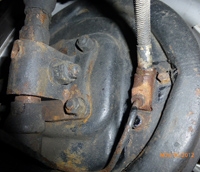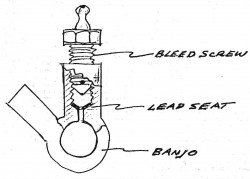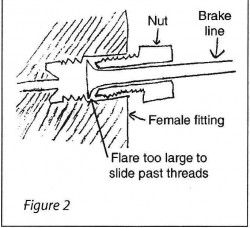Brake Line Flares and Bleed Screws

 Leaking Bleed Screw – Don Fox of Wilmette, Illinois, sent me his solution to the problem of a leaking rear brake bleed screw.
Leaking Bleed Screw – Don Fox of Wilmette, Illinois, sent me his solution to the problem of a leaking rear brake bleed screw.
Apparently, the bleed screw had been over-tightened at sometime during its life, and its seat in the brass banjo fitting had developed small cracks. New banjo fittings are relatively expensive items, so Don sought an alternative solution for which he provided a diagram and described as follows: “I placed a drop of molten solder on a flat surface and immediately flattened it into a thin wafer. With scissors, I cut it to a diameter that fit into the bore of the banjo cylinder, and drilled a small hole in the center. Dropping it into the bore and replacing the bleed screw, I ended up with a lead seat that stopped the leak.” (See Figure 1).
 If it cured the leak, it sounds like a good solution to me!
If it cured the leak, it sounds like a good solution to me!
More On Brake Line Fittings – Blake Urban of Aberdeen, South Dakota, took me to task over my statement in my last article that the brake line flares can be compressed in a vise if they have spread too wide to insert easily into the fittings.
Here is what he wrote:
“I would not compress the circumference of the flare to get it to fit inside the threaded bore. Compressing the flare could cause distortion and therefore more problems with leaks. Leaks are cured by tightening the flare nut which exacerbates the original problem. The advice from Ron Hulbury in the last issue of MGA! would be better if the filing were also done around the circumference.
“The problem of getting the union to fit arises from excess tightening. Tightening a flare causes the flared end to open more and the metal to thin toward the outside edge and to work-harden. Therefore, the greatest thinning and hardening takes place at the extreme outside edge. Filing around the circumference removes the weakest section. If one is concerned about the thinning of the flare, there is usually enough length on the pipe to cut off the old flare and to flare the new one.
“Most people tighten flared fittings too much! A flared fitting should be tightened snugly with the least amount of torque to keep the fitting from leaking. If upon checking after reassembly leakage is noted, the fitting should be tightened just until it stops leaking, and no more. A clean, undamaged fitting should need only firm tightening to keep it from leaking. Reverse flare fittings work just like spark plug gaskets, and over-tightening will only make the problem worse by crushing the flare. The manual for my Datsun pickup specifies only 11-13 foot pounds of torque for the brake tube flare fittings. This would require a ⅜” drive, and preferably a ¼” drive, torque wrench to measure. Pulling on the end of a six-inch (0.5 feet) flare nut wrench with a spring scale until it reads 24 pounds would also give 12 foot pounds of torque. (Lever arm length times force equals torque. A nine-inch wrench [0.75 feet] would need 18 pounds of force.)
“The reason the fitting won’t go together is because the female fitting is not threaded top to bottom. The outside section is bored larger than the threaded area to allow easy insertion of the flare nut. When the tube’s flare becomes larger than the threaded bore (Figure 2), it won’t slide inside far enough and the flare nuts threads cannot start on the threaded section of the female fitting. This occurs where we cannot see what is happening. Filing makes the flared tube small enough to slip past the threads and then the nut can be restarted”.
 Well, Blake is absolutely right, and I stand corrected. He added a post script in which he said that the end of the nut sometimes spreads and can cause the same problem. This is the problem I have often had, particularly on T-series cars with their softer fittings. It is the spreading of the nut end that I correct with gentle pressure around the circumference with a vise. Incidentally, Blake mentioned re-flaring the brake line ends if necessary, which requires a special flaring tool to form the double, or reverse, flare and not the single flare shown in Blake’s drawing. The more common, hardware store flaring tool producing a single flare is not suitable.
Well, Blake is absolutely right, and I stand corrected. He added a post script in which he said that the end of the nut sometimes spreads and can cause the same problem. This is the problem I have often had, particularly on T-series cars with their softer fittings. It is the spreading of the nut end that I correct with gentle pressure around the circumference with a vise. Incidentally, Blake mentioned re-flaring the brake line ends if necessary, which requires a special flaring tool to form the double, or reverse, flare and not the single flare shown in Blake’s drawing. The more common, hardware store flaring tool producing a single flare is not suitable.

